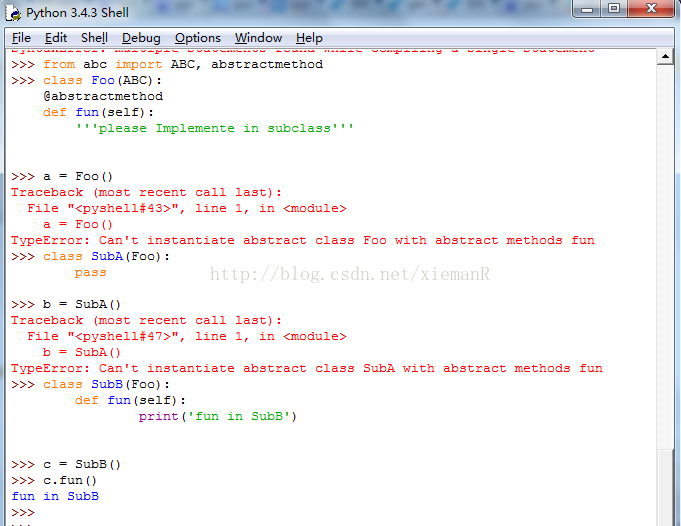Python2和Python3中@abstractmethod的用法
Posted 邱明成
tags:
篇首语:本文由小常识网(cha138.com)小编为大家整理,主要介绍了Python2和Python3中@abstractmethod的用法相关的知识,希望对你有一定的参考价值。
抽象方法:
抽象方法表示基类的一个方法,没有实现,所以基类不能实例化,子类实现了该抽象方法才能被实例化。
Python的abc提供了@abstractmethod装饰器实现抽象方法,下面以Python3的abc模块举例。
@abstractmethod:
见下图的代码,基类Foo的fun方法被@abstractmethod装饰了,所以Foo不能被实例化;子类SubA没有实现基类的fun方法也不能被实例化;子类SubB实现了基类的抽象方法fun所以能实例化。
完整代码:
在Python3.4中,声明抽象基类最简单的方式是子类话abc.ABC;Python3.0到Python3.3,必须在class语句中使用metaclass=ABCMeta;Python2中使用__metaclass__=ABCMeta
Python3.4 实现方法:
from abc import ABC, abstractmethod
class Foo(ABC):
@abstractmethod
def fun(self):
‘‘‘please Implemente in subclass‘‘‘
class SubFoo(Foo):
def fun(self):
print(‘fun in SubFoo‘)
a = SubFoo()
a.fun()
Python3.0到Python3.3的实现方法:
from abc import abstractmethod, ABCMeta
class Bar(metaclass=ABCMeta):
@abstractmethod
def fun(self):
‘‘‘please Implemente in subclass‘‘‘
class SubBar(Bar):
def fun(self):
print(‘fun in SubBar‘)
b = SubBar()
b.fun()
Python2的实现方法:
from abc import ABCMeta, abstractmethod
class FooBar():
__metaclass__ = ABCMeta
@abstractmethod
def fun(self):
‘‘‘please Implemente in subclass‘‘‘
class SubFooBar(FooBar):
def fun(self):
print(‘fun in SubFooBar‘)
a = SubFooBar()
a.fun()以上是关于Python2和Python3中@abstractmethod的用法的主要内容,如果未能解决你的问题,请参考以下文章
